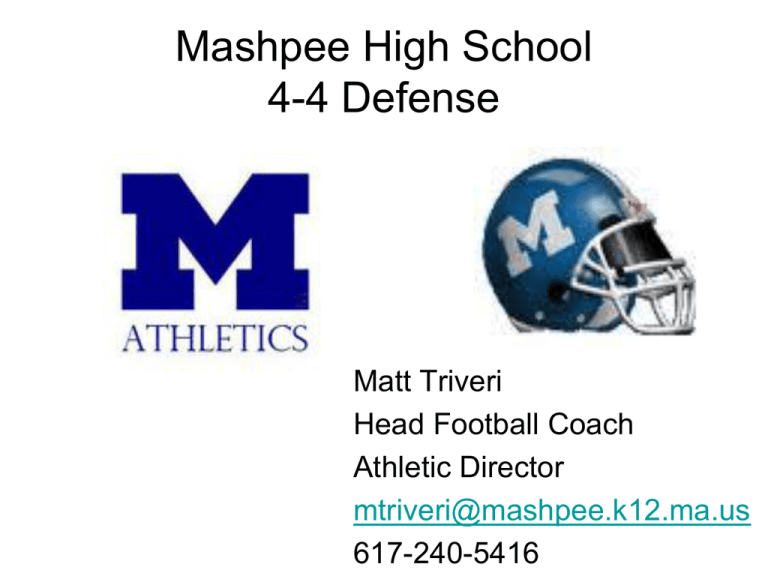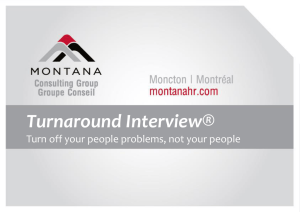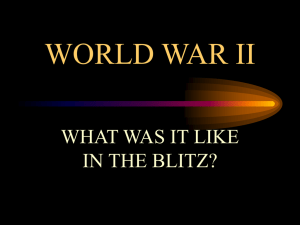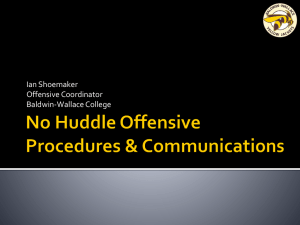Defensive Tackle - Glazier Clinics
advertisement

Mashpee High School 4-4 Defense Matt Triveri Head Football Coach Athletic Director mtriveri@mashpee.k12.ma.us 617-240-5416 2011 Division IV Eastern Massachusetts Champions 13-0 Program History • Our current staff took over in 2005 when I became head coach • Mashpee began football in 1998 and had a full varsity schedule by 1999. • Our staff inherited a program that went 15-40 from 19992004 • Previous coaching staff(s) actually did a pretty good job teaching fundamentals and X’ and O’s; our focus was on adding toughness, getting speed on the field and being aggressive • The current core of our staff (6 coaches) have been together for the past four years Defensive Successes • Using the 4-4 exclusively the past seven years, Mashpee High School has achieved the following: • A 62-16 record • 2011 Eastern Massachusetts Super Bowl Champions (13-0) • Gave up 4 rushing touchdowns in 2011 • Recorded 10 shutouts • Held 20 other opponents to one score • Led the state of Massachusetts in points against in 2008-2009 at 6.9 points per game Continued • Finished 6th in the state of Massachusetts in points allowed at 10.1 points per game in 20082009 • Allowed only 8 100+ yard rushers in last 78 game • Given up 26 plays of 40+ yards defensively in last 78 games • In seven season (78 games) have allowed 36 touchdown passes and had 81 interceptions Why We Use The Split 4-4 • Well-suited for the type of kids we have; somewhat undersized, but quick and athletic • You do not need a lot of big bodies (this is perfect for us as we have a limited number of kids, and many play both ways, this limits the need for bigger linemen to play a lot of defense) • Strong against the run (in our league and state, we see a lot of run-orientated teams, most run/pass ratios of opponents are 65/35 • Great defense to stunt and blitz out of, very flexible Why We Use The Split 4-4 • Forces a lot of doubles, leaving second level players free to read and run • Ability to hide average players at certain positions • Can plug many types different kids into a number of positions, and they can be successful through discipline and technique, they do not have to be overly athletic and fit physical minimums • Allows great players to flourish by creating schemes to allow them to maximize physical skills Why We Use The Split 4-4 • Adjustments against to different offenses are fairly simple • Flexible against teams that are very multiple • Individual alignments and techniques are not difficult to teach • Base alignment creates many issues for offensive lines in terms of angles and blocking assignments • Tends to create many 2nd and 3rd and longs, which allows us to do different things coverage and pressure-wise Overall Defensive Philosophy • • • • • • • • • • • • • Play snap to whistle at 100%, never give up on a play Be highly physical Be a great tackling team Be sound from a technique standpoint; INDY periods win titles We dictate and attack at all times (through movement, blitzes, speed, physicality) Play fast and loose; overanalysis=paralysis Refuse to be blocked Stop the run, then attack the pass Attack the football; create turnovers Dominate the line of scrimmage, get up field, play downhill Do your job; but play as a team; one heartbeat Mental toughness (11 foxhole guys) Spartan mentality Teaching Progression 1. 2. 3. 4. 5. 6. 7. 8. 9. 10. Alignment Stance Keys Reads Technique Different Types of Tackling Ripping/Shedding/Evading Blocks Down and Distance Recognition and Understanding Formation/Play Correlations Perfect Use of Movements; Taking Proper Angles Personnel • • • • Personnel all depends on the type of kids you have year to year; for us we try to identify kids early that fit certain criteria we use for each position and develop them into an outstanding player after one to two years of instruction Should be noted: We change positions of personnel nearly every game depending upon the opponent and their offensive packages and schemes We believe every it is imperative to take away each opponents greatest assets by putting our personnel in different spots each week This also makes us difficult to prepare for Personnel (Continued) • 1. 2. 3. 4. 5. • 1. 2. 3. For us the most important positions in our 4-4 are: Will Linebacker Free Safety Anchor (Strong DE) Spur/SAM DT (5/3 Technique) For us, the positions we feel like we can use “average” kids and still be successful (positions of least emphasis) Bandit Defensive End (Weak) Nose Tackle Personnel By Position Attributes Nose Tackle • - Optimal player for us is: a fullback type player from 190-220 pounds powerful (strong hips and legs) quick and relentless a true one gap player that is disruptive and cannot be reached in a zone scheme and will pursue flat - currently have one: 5’11 200 TB 4.6 Speed, 250lb clean; stud who is very disruptive 7 sacks, 11 TFL’s • On the opposite end of the spectrum, we have used OL kids that try to eat up a guard and center and let the Will run around Personnel By Position Attributes Defensive Tackle • Our best or second best offensive lineman plays here • Size is not a must; but helpful • Must be a technician • Be able to read helmet and fight doubles • Quickness helps, but must be stout • Currently 2 kids rotate, one is 6’5 320 then other 5’7 190 (power lifting champion) Personnel By Position Attributes Anchor (Strong side DE) • This should clearly be the better of the 2 DE’s; a stud • Be strong enough not to be turned out, but quick enough not to get hooked • Must be physical; attack power and traps violently (looking to wrong-arm and spill) • Initial burst and athleticism a huge plus • Usually taller and athletic, TE types, have had kids ranging from a 6’1 220 pound QB, a 6’0 basketball kid who was a TE, to a pair of OT’s, one who was relentless at 6’4 250 and starts at UMASS as a 3-technique Personnel By Position Attributes Defensive End (Weak DE) • • Our preferred kid is Athletic; more of a pass rush kid Tough, able to take on OT’s or TE Long; ability to disrupt passing lanes We have used bigger, slower types who will control their gap, but force us to move other personnel around them • When we have longer, lean athletic kids, it allows us to really attack from the edge with many different blitz combinations Personnel By Position Attributes Mike • Bigger, stronger of the two ILB’s in general • Willingness to be violent at point of contact (vs. Iso and lead) and fight unblocked G/T • Strong tackler; what he hits must stay put or go backwards • Must read well and be able to diagnosis quick (film guy) • Usually the defensive quarterback (calls signals, strengths, etc) • Quickness is a plus, but other attributes can make up for lack of burst • Ability to shed blocks is a plus • Nearly always a “zone defender”, so more smart than athletic in pass coverage • Had Everything from 5’9 180 to 6’0 210; and guys at 5.0 to 4.7 Personnel By Position Attributes Will • • • • • • • • Should be the best football player we have Great tackler and hitter Posses quickness and athleticism Should be unblocked most of the time, thus must read keys properly and react quickly Versatile enough to cover and tackle in the open field Could actually use a DB type of kid as long as they are aggressive and smart Had 4 different kids play this position in the past 7 years and all have mad over 80 tackles in a season (two guys over 120 tackles in a year) Best guy 5’9 200, 4.7, strong, quick, instinctive, and tough- 3 year starter finished career with 274 tackles Personnel By Position Attributes Spur/Strong Safety • Must be a very good athlete to play here • Ability to play the TE side and take on lead plays, yet be able to cover slot guys • A defensive back-type of player makes sense as long as he is willing to be physical • This player moves around the most in our defense and will always be at the opponents point of strength • Needs to be a solid tackler • Must read TE/T combination quickly • Our best was a 3 year starter, 6’1 200 RB who was a 10.9 100 meters guy who cleaned 250 Personnel By Position Attributes Bandit (Weak OLB) • Many times this is out 11th best defensive player • Because he is often lined up away from strength or where we believe play is going, we like a guy who can pursue • Can be protected by the DE and NT (by alignment and movement) if he is average, if he is good, we are able to ramp up responsibilities • Has to be able to cover • Good tackle skills; has to be moderately physical “Overachievers” and intelligent football players always exceed expectations at this position • Never had a kid over 200lbs here, played with a 5’8 130 kid as well Personnel By Position Attributes Cornerback • Outside of our FS, these are the programs best athletes; we take whatever we can get, all shapes and sizes • Quickness and burst are more important than linear speed • Premium guys are usually basketball kids that have loose hips and excellent change of direction skills • Must be smart enough to handle different formations and coverage calls • Just need to proficient tacklers (especially in the open field) • Mix and match by corners size/ability/best qualities; we change by teams offence, field/boundary, size/ability of receivers, formation, etc- Responsibilities change a lot Personnel By Position Attributes Free Safety • For us, FS and Will LB are the 2 most important guys in our 4-4; has to be able to do a ton of things • Must be able to cover a lot of ground through speed, instincts, or recognition or a combination of the 3 • Must be smart; defensive quarterback, makes coverage calls • Smooth hips and fluid, basketball-type kid • Must be a sure tackler • Must be able to read the OL and flow; we train our FS similar to our ILB’s • Having a hitter is a huge plus; makes teams think twice about throwing verticals or routes inside the hashes • Our best; 3 year starter, also QB, 6’2 175, smart, all EMASS player, 9 career picks, big hitter, 7 tackles/game- all-league 2-Guard in hoop Game Week: Defensive Game Planning and Install Friday (night) - Opponent game tape is compressed and sent to every coach and player via Hudl Saturday - Coaching staff meets in the morning to go over previous night’s game and opponent film (kids have weekends off) - General defensive game plan, opponents formations, alignments, looks etc discussed - In the afternoon/evening opponents plays are broken down by formation, put in folders and sent to all football staff and players through Hudl Game Week: Defensive Game Planning and Install Sunday - Communication with/between all coaches through email, texts, and phone calls on general consensus on what we will be doing defensively against Friday nights opponent - Conversation with defensive coordinator on what stunt and blitz packages will be most effective (this is usually vs. formation and run/pass) - Create play cards for scout team to use during the week (HC And DC take a half of a game or 1 game apiece); also add in any plays from previous year(s) that were not on game tape. Trick plays, gadget plays, etc. Game Week: Defensive Game Planning and Install Monday - General defensive walkthrough with kids; focus is on opponents personnel and their abilities, scheme, tendencies (by formation, we do not do a lot of down/distance tendencies), goal line package, 2-point plays, general strengths, weaknesses, etc. - Meet with defensive coordinator to go over initial blitz package Game Week: Defensive Game Planning and Install Tuesday - Base 4-4 vs. opponent run game (3/4 speed looks) - 10 plays live Goal line/2 point plays Stunt/blitz package vs. run game Coaches evaluate our defensive plan/package vs. run game, make appropriate adjustments Game Week: Defensive Game Planning and Install Wednesday - Defensive 7 on 7 against opponent pass game - Team vs. opponent pass game (includes screens and draws as well); 20-25 plays - Pass blitz scheme vs. air, then semi-live - Add in any run adjustments and briefly go over goal line and 2-point plays Game Week: Defensive Game Planning and Install Thursday - DL/LB’s group up to go over alignments, responsibilities, and what plays they are going to see; all mental (5-10 min) - DB’s/LB’s group up to go over pass game and coverages and option responsibilities and calls vs. option heavy teams - Defensive team vs. scout look (20-25 plays) - Blitz package walkthrough Alignment/Technique Chart 98 7 6 5 3 2 1 0 1 2 3 5 6 7 8 9 Alignment Addendums • We try to keep the Anchor (Strong DE) in a 9 vs. a TE and outside shade vs. a T in spread as much as possible; Reasons: - Better angle vs. power which make a wrong arm and spill much easier - Easier for a heavier, stronger DE to squeeze a hole vs. a TE/T than a OLB - Better ability to slide to an 8/headup technique and jam a good pass catching TE Alignment Addendums - vs. TE Trade/Exchange, we will balance the tackles to where we need them (i.e. 1 to 3, 3 to 1) - Linebackers must adjust as well; they must understand where the other OLB aligns (key for Bandit) - Vs. Pass Spur has slant/skinny vs. a X/Z inside move in Cover 3 - Stunts and blitzes stay on- players have to be smart enough to adjust Alignment Addendums • Vs. Motion: - Spread to Trips: Bump down Spur and Bandit Bumps out (stunts/blitz may remain, if the bandit or his end is coming we will give a base or kill call) - Pro to Slot: Bandit must bump out and trail 5X2, Spur will be head up to inside leg of TE - Slot to Pro: OLB to the Slot bumps down and is head up on the OT, OLB to the motion/pro bumps to inside leg of DE/ead Up on TE Alignment Addendums • - Vs. Motion - Jet Motion- vs. Spread, the Will or Mike will bump to head up over the OT when motion is at them, this will allow them to scrap the jet and avoid being blocked (Anchor/DE must jam). The other MLB is over the center. The OLB that has motion going away will bump down to inside leg of the DE. In Cover 3 he is responsible for slant/skinny on a WR inside stem. In Cover 13 (split field back to his side or inside cross). The OLB that has motion at him slides to head up on the slot (read keys do not change). Alignment Addendums • Vs. Motion - Flexbone: Would depend upon how many and how often an opponent counters off motion - Against teams that use basic FB trap or counter, we often automatically crash the defensive tackle away from the motion to take away trap and help vs. midline and follow - When we do this with the DT, the DE away from the motion will slide to a head up position against the tackle and attempt to take away counter and slow any option away from motion - Linebackers will bump down, BS OLB stacks on the DE, BS ILB goes over center, and PS MLB to head up on OT, with PS OLB stacked on wing/RB Fronts 51 Front (Base 4-4) B DE W NT S M T An 22 Front B DE W NT M T An S 31 Front B DE W NT M T S An 11 Front B DE W NT M T S An 31 G Front B DE M NT W T An S 51 Front Strong Over DE W B NT M T S An Alignments and Match-Ups vs. Formations Vs. Pro and Slot Pro - Must stop downhill runs - Protect C Gap and kill the trap to the 5 tech with the Will reading fast - Looking boot out of base I and hitch, slant to the open side of the formation (Bandit) - Other issues: Double Dive, Veer, multiple option Slot - Look for lead/power to the slot, LB in B Gap must be physical - End trap/Counter to the TE, must for to the free corner - Iso to the TE side is an issue - Look for slot combination routes; curl/flat, smash, NCAA- cheat FS vs. Pro FS C B DE W NT C S M T An Y X QB FB H Z vs. Slot FS C DE B T C S W M An NT Y QB FB H X Z vs. Wing (To TE) FS C B DE W NT X C M T S An Y QB FB H Z vs. Tight Slot/Wing Away FS C B DE W T M NT Y QB FB H C S An X Z vs. Wing T FS C B NT W DE X C M T S An Y QB H FB Z Vs. Spread • Very important: determine what the opponent really is out of spread and prepare accordingly • Are they run or pass dominant? If run dominant, how so; are the mainly Inside Zone, option, jet sweep, rocket, or a physical man on/gap approach (power, lead, counter, QB trap, etc.) • Are they no huddle? Hurry up? • Our game plan work of their offensive strengths in the spread Vs. Spread • Against heavy Inside Zone teams we are 1 to the back and 3 away with the tackles (been very effective for us) • Against Zone Read teams we will often have the end to the back chase and have the Mike X to the edge for QB • The bigger issues are spread teams with the capabilities to throw the bubble backside on zone and front side on veer • Inverted veer (flash/QB Power Read) and the jet sweep read of the front side end also force us to change how we approach teams that use these • We tend to be very aggressive vs. spread teams and play a lot of Cover 1 and 0; against very good pass pro teams we will play a lot of Cover 3 and look to hammer receivers vs. Spread FS C B NT S W M DE X C T H An Y QB FB Z vs. Trips FS C B DE NT C M T X S W An Y QB FB H Z vs. Bunch FS C C B DE NT T W M X An S H QB FB Y Z vs. Quads FS C B DE C M NT X T An W S FB H Y QB Z vs. Empty FS C S X C M DE NT T An W H FB QB B Y Z Double Tight vs. Deuce (Even) FS C B DE X C M T W NT S An Y Y QB H Z vs. Deuce (Trips) FS C B DE M T NT C W S An Y Y QB H X Z Double Tight I FS C C DE B W NT M T S An Y Y QB F H Z Power Sets (Power I/Bone) • We will try to stay 4-4 vs. all power sets, the one exception is vs. Double Tight/Double Wing (Bay City T) we will go 5-2 and 5-3. • The Double Tight/ Double Wing Diagram is wrong, but we are slightly inside shaded tackles on OT’s, ILB’s in A Gaps, DE’s in 9’s and OLBs inside leg of DE’s. Double Tight Power I FS C C B DE W NT M T S An Y Y QB F H F Bone Double Tight FS C B DE W NT M T S An Y Y QB F H H C Double Tight Wing FS C B DE W NT M T C S An Y Y QB F H Y Unbalanced Single Wing FS C B DE W NT Y H C T M S An Y F QB H Double Split Bone FS C B DE C M T W NT X S An Z QB H F H Diamond FS C B DE C M T W NT X S An Z H QB H F Double Tight/Double Wing FS C B DE C M T W NT S An Y Y F QB H Y Aces, Twins, Other Aces FS C B DE C M T W NT S An X Z H QB F Y vs. Tight Bunch FS C B DE NT M T C W An X S Y QB FB H Z vs. Twins FS C W DE X T M NT C B An S Z Y QB FB H vs. I- Twins (Open) FS C W DE C M B T NT An S X Z QB FB H Y vs. Pro Trips (Y-Trips/Trey) FS C W DE NT M X C B T S An Y QB FB H Z Keys/Reads Defensive Tackle/Nose Tackle • When we are in base we are “reading helmet” • We do this by getting up field and attacking • Difficult to learn, most kids get it by their junior or senior year; like riding a bike • Gapped a ton so, being able to feel doubles and decipher between a down block and reach are critical Defensive End/Anchor • When in an outside 9 shade on a tight end or outside 7 shade on a tackle, they are attacking the outside half and reading the block • Turnout block=squeeze (we previously ripped with the outside arm under and blew up the hole, but this killed our OLB read-they hit the hole) • Hook block=Control, use hands, or rip outside • Reach/BS Zone=Squeeze, then look for trap/counter/ (wrong arm), reverse; chase flat • Power/Trap=Wrong arm and spill Inside Linebackers • • • • Read Key: Near Guard Secondary Key: Center Read from guard/center to fullback Vs. heavy IZ teams, we are one back/flow Outside Linebackers • • - Spur: TE/Tackle combination Run/Pass should be diagnosed early Key read in the TE on DE If TE hooks=Get wide for lead block If TE turns out and T down=Fill C Cap ASAP If TE and T reach/zone=Get flat, but find away guard to see if there is a pull coming your way - Vs. Power/End Trap/Counter=Get to the LOS and be ready for the back to bounce, the end will wrong arm and spill Cornerbacks • In Cover 3, we key the near tackle to diagnosis run or pass, making sure the tackle is getting up field and PAP • Against 2X2 teams that use a lot of zone our corners are particularly careful • In Cover 1 we do not read, we are locked on to the WR Safety • While driving back, our safety will read the strong side tackle and guard to determine run or pass • His read is similar to an inside backer, with much greater responsibilities • Down and distance will dictate aggressiveness and film study is huge in terms of recognition and feel Stunt/Blitz Package • Our stunt/blitz package is a little different than many others: we call each stunt/blitz by position and do not use one or two words for multiple movements • Our calls would be Pinch Strong, Loop Weak Machete B Strong, Machete A Weak Cover 1 • We do not use Storm Strong, Gator, Thunder etc. • Advantages: We can get very creative and come from all angles, it is also easy to learn for kids, as they have to learn their couple of movement and just listen for them; colors coordinate to formation making it easy to adjust vs. high tempo teams • Disadvantages: Very long/wordy, the safety (who makes coverage calls/adjustments must be smart, LB’s must understand DE blitz and vice versa. Coaches must be organized and have coverages added into packages • To combat these disadvantages we use wrist coaches 1. BASE 2. X WEEK (3) 3. X WEEK SHOOT STRONG C (0) 4. X WEEK END PINCH STRG SHOOT STRONG C (0 5. DOUBLE LOOP DOUBLE MACHETTE A (1) 6. DOUBLE PINCH DOUBLE MACHETTE B (1) 7. LOOP STRG PINCH WEEK SHOOT WEEK C(0)A 8. END PINCH STRG SHOOT WEEK C (0) 9. X STRONG SHOOT WEEK C (0) 10. X STRONG LOOP WEEK MACHETTE A WEEK (1) Playoff 1. BASE 2. DOUBLE ONE’S END PINCH STRONG (1) 1st and 2nd down 3. END+TACKLE PINCH STRONG SHOOT WEEK B(1) 1st and 2nd down double tight / Pro 4. STRONG OVER MAC(A)STRONG MAC(B)STRG(1) 1st and 2nd down Pro / Jet/ lead 5. 4-5 LOOP STRG MACH A STRG SHOOT WEAK B(1)1st and 3rd down and 5 up Pro/DT boot pass/CT/weak lead/lead 6. 5-4 LOOP STRG MACH A STRG SHOOT WEAK B(1) 1st and 3rd down and 5 up Pro/DT Any down / Pro and spread boot pass/CT/weak lead/lead/sweep 7. LOOP STRG MACH A STRG PINCH WEAK(3) Any down/ Pro and spread 8. PINCH STRG LOOP WEEK MACH A WEAK (3) Any down/ Pro and spread 9. DOUBLE LOOP DOUBLE MACH A(1) Any down/ Pro and spread 10. DOUBLE PINCH DOUBLE MACHETTE B(1) Any down/ Pro and spread Stunt/Blitz Package • We must make a strength call • Usually dictated by a TE • When even, it may by to the field side or to a strong side of a line • Against spread teams we sometimes go away from the back other times towards, it depends on what the do as far as strengths • The strength call is crucial because we stunt/blitz using strong/weak as an indicator • There are times when we send OLB’s that we can play Cover 1 or Cover 3 (in 3 we take the ILB and send him into the flats Stunt/Blitz Package DT Stunts: - Pinch Loop Go Twist DE Stunt/Blitz: - Pinch Loop (from a head up position) X Twist Stunt/Blitz Package ILB Blitz: - Machete (Gap call follows) X (vs. Spread/Trips) OLB Blitz: - Shoot (Gap call follows) X Double Loop, Double Machete A FS C W DE B C M NT T X S An Y QB FB H Z Double Pinch, Double Machete B FS C B DE W NT X M T C S An Y QB FB H Z End Pinch Strong C FS B DE W NT X C M T S An Y QB FB H Z Pinch Strong, Go Weak, Machete A Weak, Shoot B Weak C FS B DE W NT C M T X S An Y QB FB H Z Double Go, End Pich Strong, Machete B Strong, Machete A Strong FS C B DE W NT X M T C S An Y QB FB H Z Pinch Strong, End Loop Strong, End Pinch Weak, Double Machete A, Double Shoot C FS C B DE W NT X C M T S An Y QB FB H Z Same Blitz With Different Coverage Shoot Strong C, Shoot Weak B (Cover 0) C FS B DE W NT X C M T S An Y QB FB H Z Shoot Strong C, Shoot Weak B (Cover 3) FS C B DE W NT X C M T S An Y QB FB H Z Shoot Strong C, Shoot Weak B (Cover 1) FS C B DE W NT X C M T S An Y QB FB H Z Blitz vs. Spread Double Loop, Double Machete A FS C B X DE M NT C W T H An S Y QB FB If Back is on a swing, arrow, etc. the DE that side must detach and cover in Cover 1 Z X-Strong (End/ILB- Run vs. Zone Read Teams) FS C B X DE M NT C W T H An S Y QB FB Z Double End Pinch, Double Shoot C (Cover 0) FS C B M DE X NT C W T H An S Y QB FB Z Slant • This is the only stunting we do that is a “one’ call for us and it is usually done vs. flexbone teams • Going into a game our defensive line will know to slant towards the motion call (cutting off trap and counter) • Rarely we use this as slant strong or slant weak Slant vs. Aces FS C B DE C M T W NT S An X Z H QB F Y Mashpee 4-4 Stack Defense Defensive Coverages and Responsibilities 4-4 Stack Defensive Coverage(s) • Primary: Cover 3 • Secondary: Man Free Run vs. spread teams (2x2) sets • Checks: Split Coverage Calls. • Man All Over including Safety • Split field coverage-Coverage vs. formations • Cover 2 – 12 rolls corner up, shift $$ over the top, roll OLB Deep Overall Philosophy/Rules • CB: – Alignment: 6 yds. x 2yds inside leverage • Always taking away slant and post • We can run with the fade/corner – Must assess # of threats to deep 1/3. • If #2 is a skill player, the CB cannot jump the hitch • If #2 is a TE, the CB can jump any 3-step routes – Checks (Motion/Formation) • Cov 3 Zone to trips, man principles backside • Man on Coverage across the board • Corner Jams/Funnels #1 inside and retreats to flat (10-12 yds. Deep) Rules For Safety • Safety: – Alignment: • 10-12yds from LOS. Shade Strength • Can also motion to alignment pre-snap – Responsibilities: • Deep middle in straight Cover 3 Zone • Split the two with a shade to the QB’s hand vs. Spread • Make all checks based on the following: – Blitz/Stunt Call, Formation, and Motion Basic Cover 3 Responsibilities vs. Pro/Slot •o oooxoo C o C Deep 1/3 S Deep 1/3 Shade Strength Deep 1/3 Corner Must Assess # of Threats to Zone Example: If it is a Pro Formation with and X, Y, and Z, the corner may jump any route. Corners are to take inside leverage vs. Spread (Cover 3) •o o ooxoo ( Jam to Flat) LB LB LB C o o LB (Jam to Flat) C Deep 1/3 Deep 1/3 S - Shade Strength Deep 1/3 - Strength would be Hand of the QB - Checks are Dependent on Stunt/Blitz call vs. Spread (Cover 3 Buzz) • o o ooxoo LB LB C LB o o LB C Deep 1/3 Deep 1/3 S - Looking to jump any quick routes with LB’s - OLB’s start head up, ILB’s widen to make any easier run - Sprint to zones on snap of the ball (no jam) - Defensive tackles will not rush and look fro screen/draw Split-Field Coverage (12) •o C o LB ooxoo LB LB o LB o (MAN) C Jam to FLAT MAN FS (Deep 1/2) Cover 2 to one side, Man to the other We Like to use this to jump hitch/fade, smash, hitch/hitch VS Empty •o o ( Jam to Flat) LB ooxoo o LB LB o LB C o (Jam to Flat) C MAN MAN S Man Coverage ALL IN VS Sprint Out • All Defensive Backs check to Roll Coverage to the Sprint-Out side • CB Locks onto closest man • Safety locks onto crossing route • Backside CB Rolls over the top taking away backside post Roll Coverage vs. Sprint Out/Boot •o ooxooo C o C S Safety Jump Cross Roll side CB Lock on Backside CB Rolls over top (inside leverage of backside post/crossing route VS 3-Level F •o oooxoo LB LB C LB o LB C S VS Trips (13) o o o o LB o ooxoo LB o LB LB C C Deep 1/3 Man on Backside S Shade Strength Deep 1/3 13 Check can be made if motion creates a 3x1 set or by straight formation If there is a dead end side, CB has back out of Backfield Drills: Basic • Threat Assessment Drill: By formation and Motion • o oooxoo o 1- threat C C jump hitch and slant Deep 1/3 Deep 1/3 S Shade Strength Deep 1/3 (play over top of TE) • • • Corners should be able to determine # of real threats to zone and make decision on how to cover their 1/3. (Show tons of formations) Scout team will run route combinations to finish up drill (go over all possible route combos) Include “Cover 3 beaters” TE is not a real threat (unless he is a mismatch). Safety will be responsible for TE over top. Contact Info • Please feel free to contact me if you need anything. • I can send cutups as well • mtriveri@mashpee.k12.ma.us





